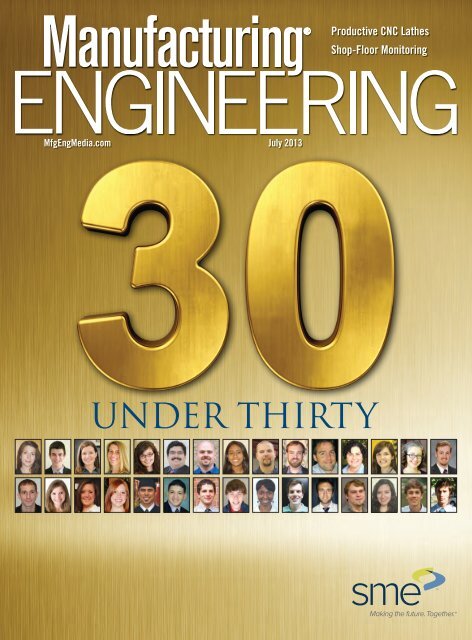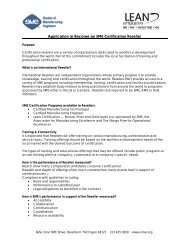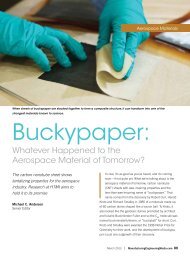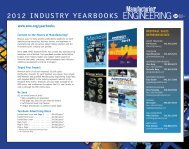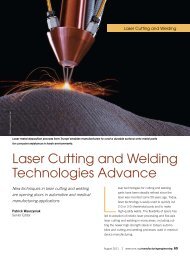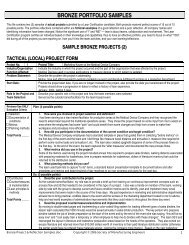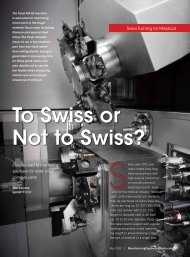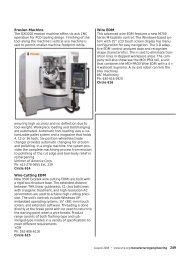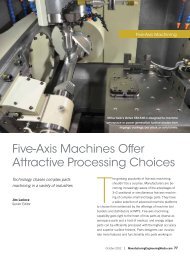UNDER THIRTY - Society of Manufacturing Engineers
UNDER THIRTY - Society of Manufacturing Engineers
UNDER THIRTY - Society of Manufacturing Engineers
- No tags were found...
You also want an ePaper? Increase the reach of your titles
YUMPU automatically turns print PDFs into web optimized ePapers that Google loves.
Catherine RossAge: 30National Institute for Metalworking Skills (NIMS)Fairfax, VAShe may not be an engineer and she may nothave a role in building any actual parts orproducts, but Catherine Ross received a flurry<strong>of</strong> nominations for her work in helping to attractand develop a competent manufacturing workforcefor the future.Importantly, she is a strong reminder that importantmanufacturing work sometimes happens far from thefactory floor.Catherine holds a degree in sociology from GeorgeMason University and is director <strong>of</strong> accreditationfor the National Institute <strong>of</strong> Metalworking Skills.She joined NIMS in 2008 with some old (dirty,dangerous) ideas aboutmanufacturing that werequickly turned on their head.“It has been one long learningexperience,” Catherine said<strong>of</strong> her time at NIMS. “All year long, there are newadvances.” She describes the modern manufacturingfacilities with which she is now acquainted as “some<strong>of</strong> the cleanest, safest facilities I’ve ever had theopportunity to experience.”Catherine now promotes the field <strong>of</strong> advancedmanufacturing to students, teachers and parents,and helps to connect education to industry inimportant ways through a variety <strong>of</strong> programs andoutreach efforts.Her primary role at NIMS is overseeing the nation’ssole accrediting body for training programs inprecision machining. Under her direction since 2009,more than 120 training programs have been accreditedand no less than 135 training programs haveapplied for accreditation.One <strong>of</strong> the Catherine’s important projects is marketingand organizing the three national-level SkillsUSA"A close tie to local industry andemployer and trade associationscan make a world <strong>of</strong> difference."<strong>UNDER</strong> <strong>THIRTY</strong>contests for CNC milling, CNC turning and precisionmachine technology. “We’re seeing more and morestudents in the national contests,” Catherine said. “It’sdefinitely growing.” She enjoys seeing an increasingnumber <strong>of</strong> women at the national level, which meansthey beat out their male peers at the state.She also coordinated the AMT-sponsored StudentSummit at IMTS in 2012, where attendance exceeded9,000. The event was designed to introduce youngpeople to STEM-related careers in industry. Similarly,she coordinated Student Day at PMTS.Catherine also participates in industry’s educationalevents, through efforts such as Haas HTEC Network Regionaland National Conferencesand Sandvik Coromant’s Bridgingthe Skills Gap series.She believes this is importantwork that can make a differencelong term. “A close tie to local industry and employerand trade associations can make a world <strong>of</strong> difference,”she said. “Employers can tell educators exactly whatthey need.”Through her varied efforts, Catherine sees a wholehost <strong>of</strong> things that can be done to improve the image<strong>of</strong> manufacturing and make sure it’s a career path thattalented students at least consider. Students, she said,seem most engaged by 3D printing, robotics, manufacturings<strong>of</strong>tware and computer-aided design. If you canget a student to design something in CAD, she observed,you can attract them into learning how to makeit with a combination <strong>of</strong> technical and theoretical training.Catherine said her goal for the future is to continuestrengthening ties between education and industry. SaidCatherine: “I do plan to stay in this industry and withNIMS. … The longer I’ve been here, the more capableI’ve become.” ME<strong>THIRTY</strong> <strong>UNDER</strong> <strong>THIRTY</strong> PROFILES2 <strong>Manufacturing</strong>EngineeringMedia.com | July 2013
Alexandria MoseleyAge: 23Graduate, Oregon State UniversityNewberg, ORAlexandria Moseley distinguished herself asa manufacturing leader during her collegecareer at Oregon State University.She recently graduated with two bachelor’sdegrees, one in industrial engineering and theother in manufacturing engineering. Alexandria saidshe chose the two degrees because she found them tobe a “good balance <strong>of</strong> theory and hands-on work.” And,she proudly noted, “I have spent a lot <strong>of</strong> time in machineshops, even smaller machine shops.”But her double major and straight As weren’t allthat set her apart. Alexandria has been an ambassadorfor the manufacturing industry and a leaderas the chair <strong>of</strong> her SME student chapter, wrote KarlR. Haapala, Ph.D., assistant pr<strong>of</strong>essor, School <strong>of</strong>Mechanical, Industrial and <strong>Manufacturing</strong> Engineeringat OSU. “She is a wonderful student, communitymember, leader, and most importantly, person,”Haapala wrote. “Alexandria has positively influencedour School and College.”Alexandria’s leadership has been recognized before.National <strong>Engineers</strong> Week 2012 recognized her as one<strong>of</strong> the “15 New Faces <strong>of</strong> Engineering—College Edition,”which was sponsored by SME. She has received severalscholarships, including the SME Directors Scholarship,in 2010 and 2012.In addition, she is participating in the MECOP program,which places high-achieving students into two6-month industry internships during their last two years<strong>of</strong> school. While interning at A-dec and Welch Allyn fora total <strong>of</strong> 15 months, she used lean principles to reducerework, identify root causes <strong>of</strong> quality issues, andimprove the flow <strong>of</strong> finished good production processes.She helped save over $17,000 per year in direct laborat A-dec and helped uncover a 3% defect rate in amajor product line at Welch Allyn.<strong>UNDER</strong> <strong>THIRTY</strong>She also served the College and School as a researchassistant, teaching assistant, and as an OSU EngineeringAmbassador. She has spent the past four years raisingawareness <strong>of</strong> career paths in manufacturing amonghigh school and college students. Whether giving acampus tour or presenting to a classroom, she emphasizedthe key roles that industrial engineers and manufacturingengineers play in sustaining the economy.As chair <strong>of</strong> the SME student chapter, she facilitateda series <strong>of</strong> club events that developed technical andpr<strong>of</strong>essional skills <strong>of</strong> engineering students. She volunteeredto assist with the 2011 SME North American<strong>Manufacturing</strong> Research Conference and a project tomachine key chains for the 2011 Beaver Open Houseto hand out to prospective students. She was also aguest speaker at the 2012 SME Annual Conference inCleveland, OH.Alexandria lamented the fact there “were so few”women in her classes, but she thinks that is changingquickly because <strong>of</strong> many new outreach efforts. And sheherself tells potential students that manufacturing andengineering is really about design, which has a lot <strong>of</strong>appeal to her peers. “I tell them … every product is notonly designed but engineers design the way it is built.”Alexandria’s next steps are to pursue a master’s degreein engineering management at Technical University<strong>of</strong> Denmark in Copenhagen.“I would like to work in operational management,”she said. “I’d like to manage a production facility ormany production facilities.” In particular, Alexandriasaid that she is interested in food production andautomation.Despite her achievements, Alexandria says she isn’tso much scientific in her thinking as logical and processfocused. “I have always been logically oriented,” shesaid. “I do experiment with crafts and cooking.” ME<strong>THIRTY</strong> <strong>UNDER</strong> <strong>THIRTY</strong> PROFILES6 <strong>Manufacturing</strong>EngineeringMedia.com | July 2013
Sri AtluruAge: 28Sandvik Machining SolutionsMebane, NCGiven his technical achievements in the field<strong>of</strong> manufacturing, it may be difficult to believethat Sri Atluru is just 28 years old.For example, Sri designed and helpedimplement a prototype “supervisory system” for theSmart Machine Platform Initiative (SMPI), which wasinitiated by the Coalition on <strong>Manufacturing</strong> TechnologyInfrastructure and TechSolve, Inc., to revamp theUS manufacturing sector. The program was fundedby the US Army.“Various integration and next-generation automationsolutions that Sri worked on during the programwere demonstrated live and real-time to a number <strong>of</strong>defense and industry leaders between 2007–2010,”Radu Pavel, Ph.D., Machining/GrindingResearchEngineer at TechSolve, Inc.,wrote in his letter nominatingSri, who worked at TechSolvefrom 2007–2011. ”He was the principal author <strong>of</strong>technical papers concerning the automation concept,which were presented in conferences sponsored bySME and ASME.”What’s more, Sri has also made noteworthycontributions to MTConnect, which aims to addressthe long-standing gap in machine communicationstandards by advocating an XML-based open-sourcestandard.“Sri developed one <strong>of</strong> the first working MTConnectadapters to run on real CNC machines in 2008,” Pavelwrites. Sri also has authored technical papers aboutMTConnect’s implementation and applications. Sri alsoaddressed energy conservation and management issuesin his MTConnect work. Because <strong>of</strong> his credentialsand expertise, Sri was selected to lead a group session"Sri developed one <strong>of</strong> the first workingMTConnect adapters to run on realCNC machines in 2008."<strong>UNDER</strong> <strong>THIRTY</strong>about compressed air energy at the first MTConnectconference in 2011.In an interview with <strong>Manufacturing</strong> Engineering, Srisaid his love <strong>of</strong> engineering and manufacturing comesnaturally.“I’ve had a lifelong interest,” Sri said, furtherexplaining that many <strong>of</strong> his family members “were mechanicalengineers back in India.”He also credits great mentors at TechSolve for his advancement.“They were good at molding me,” he said.Sri holds a bachelor’s degree with honors in mechanicalengineering from BITS-Pilani, India, and a master’sdegree in industrial engineering from the University<strong>of</strong> Cincinnati, where he is also currently working on adoctorate degree in mechanicalengineering.Atluru believes that many<strong>of</strong> the challenges facing themanufacturing industry arenot so much technology challenges, but s<strong>of</strong>tware challenges,which is where he wants to focus his attentionsin the future.“The manufacturing industry doesn’t have widespreadaccess to s<strong>of</strong>tware with good architectureand design,” he said. “I have a manufacturing background,but I also have a good understanding <strong>of</strong>s<strong>of</strong>tware development.”And while he thinks the “manufacturing in the US isreally advanced,” he thinks it could be more so. “Theydon’t implement as many new things on the shop flooras they could. There is a mismatch between what ispossible and what is done.”Sri would like to see the rigid manufacturing cultureloosen up and be more innovative.“I think I’ve begun to see that happen,” he said. ME<strong>THIRTY</strong> <strong>UNDER</strong> <strong>THIRTY</strong> PROFILES7 <strong>Manufacturing</strong>EngineeringMedia.com | July 2013
Allen HenriAge: 28Westminster Tool Inc.Plainfield, CTTool,” said companypresident Raymond Coombs Jr.,“is a company that promotes“Westminsterinnovation and continuousimprovement, and Allen has been a perfect fit forthis philosophy.”As head <strong>of</strong> Westminster’s aerospace productiondepartment, Allen is the company’s youngest managerand is credited with creating Westminster’s AerospaceDivision about three years ago.How it happened, Allen explained, was that “a customerbrought a part to us that they hadn’t had any luckgetting made. My brother[who also worked at Westminster]started the projectand then he handed it overto me. Someone once toldme that when you’re facedwith a problem somebodysays is impossible to solve, you take what they did anddo the opposite. That’s sort <strong>of</strong> the approach I took insolving this problem.”“Since then,” Coombs said, “Allen has developedall <strong>of</strong> the processes necessary to create a completeturn-key system for the Aerospace Division.” In addition,Allen solved a crucial problem for “our leadingaerospace customer."“A part we were making for this customer,” Allensaid, “has to be coated with a resin once it’s completed.The part can’t be used, however, if resin gets inside itbecause it reduces the size <strong>of</strong> the cavity beyond therequired tolerance. These parts are expensive and thecomponent they go into is even more expensive, so Imade this little handheld tool and ground up a form toolwith a couple <strong>of</strong> bearings that can be used to clean outthose resin deposits.”"Someone once told me that when you’refaced with a problem somebody says isimpossible to solve, you take what theydid and do the opposite. That’s sort <strong>of</strong> theapproach I took in solving this problem."<strong>UNDER</strong> <strong>THIRTY</strong>“That solution,” Coombs said, “saved our customerin excess <strong>of</strong> $300,000.”Allen joined Westminster Tool upon graduating fromthe Machine Technology program at Windham TechnicalHigh School (Willimantic, CT). “My older brotherwent through the program,” Allen said, “and I’ve alwayslooked up to him. Plus, they had exploratory coursesin 9th grade so you can experience all the differentshops—architecture, carpentry, auto, manufacturing.<strong>Manufacturing</strong> came sort <strong>of</strong> easy to me.”Coombs added that Allen is always willing to learn.“He has completed 18 <strong>of</strong> the 20 on-the-job trainingmodules [Westminster <strong>of</strong>fers]and has taken numerouscourses at the localcommunity college.”And Allen is also willingto help teach. “He led thewinning team from H.H.Ellis Technical School (Danielson, CT) in a workbasedlearning program project sponsored by theQuinebaug <strong>Manufacturing</strong> Institute [QMI].” QMI is apartnership between Quinebaug Valley CommunityCollege and area manufacturers, including Westminster.QMI’s goal is to provide programs that preparepeople to work in manufacturing.“About 20 companies are now participating,” Allensaid. “Each gives a person to a high school once aweek to serve as a project expert. Ellis had a problemwith its work-study program.” With Allen’s help thestudents formed an employment agency in the schooland hosted an actual job fair where several manufacturers,colleges, temp agencies, and other expertsprovided advice and tips on interviewing and resumewriting. “About four or five kids have gotten jobs already,”he said. ME<strong>THIRTY</strong> <strong>UNDER</strong> <strong>THIRTY</strong> PROFILES8 <strong>Manufacturing</strong>EngineeringMedia.com | July 2013
Ananya RajagopalAge: 14StudentDublin, OHAnanya Rajagopal is someone for whom lookingforward and giving back are both important.Shortly after being interviewed forthis pr<strong>of</strong>ile, the ninth grader e-mailed usasking that we include what she feels to be verycrucial points concerningher attitude towardmanufacturing, engineeringand STEM education.“Along with going tocollege,” she wrote, “fiveyears from now I also wantto promote women in the STEM field. I think it is veryimportant that girls and women become involved in thisfield because we have lots <strong>of</strong> new ideas and opinions to<strong>of</strong>fer. I have always been the minority, being a girl. Manytimes, we are overlooked.“Sometimes I have to work twice as hard in order toprove myself. Once I graduate from high school, I hopeto talk to other schools and encourage girls to try outthis field. I know lots <strong>of</strong> girls my age that would love todo Robotics, but they don’t because not enough <strong>of</strong> theirfriends are involved. Promoting women in STEM is definitelyanother part <strong>of</strong> what I want to do later in life.”So far in life, Ananya has already accomplishedquite a bit.For four years in a row her science projects havebeen included in the state science fair. Her experimentshave ranged from testing the Vitamin C content in differentbrands <strong>of</strong> oranges (6th grade) to testing materialsthat could be used in cell phone cases to block radi<strong>of</strong>requencies in order to protect users from harmfulradiation (9th grade).In 8th grade, she was elected project manager forher FIRST Lego League (FLL) team, which she joined in"I think it is very important that girls andwomen become involved in this fieldbecause we have lots <strong>of</strong> new ideas andopinions to <strong>of</strong>fer. I have always beenthe minority, being a girl."<strong>UNDER</strong> <strong>THIRTY</strong>6th grade. (Being in high school this year she participatedin the FIRST Robotic Competition.)“This is a role in which she excelled,” said PaulGlaubnitz, who was Ananya’s FLL coach and who nominatedher for 30 Under 30. “Ananya divided the workamong the team members,taking their interests intoaccount when possible. Shealso took a generous share<strong>of</strong> the work for herself. If ateam member wasn’t pullingtheir weight, she nicely butfirmly let them know they were letting the team down.They got the work done soon afterwards.”“We created an erasable bar code,” said Ananya, “tokeep consumers from buying contaminated food. It’s atime and temperature-based innovation. A part <strong>of</strong> thebar code is covered by ink that is released when themeat reaches the maximum safe time it can be exposedto dangerous temperatures.”The project won the FLL Global Innovation Award.In addition, Ananya said, “My team filed a utilitypatent on it, and we also came together to form ourown LLC.”Ananya definitely wants a career in engineering.“I might go into chemical engineering or biomedicalengineering,” she said. “For college I want to go to YaleUniversity or Carnegie Mellon or possibly Ohio StateUniversity.”The soon-to-be 10th grader has interests outside <strong>of</strong>the classroom and STEM as well. “I was on the swimteam for five years for my district and I was on thecross-country and lacrosse teams for three years. I alsovolunteer at COSI (the Center <strong>of</strong> Science and Industry inColumbus, OH).” ME<strong>THIRTY</strong> <strong>UNDER</strong> <strong>THIRTY</strong> PROFILES9 <strong>Manufacturing</strong>EngineeringMedia.com | July 2013
Raymond ManningAge: 29Boeing Satellite SystemsPlaya del Rey, CA"The FIRST Robotics competition got meinterested in manufacturing. ... FIRST gotme wanting to do something where youactually make something."<strong>UNDER</strong> <strong>THIRTY</strong>childhood,” Ray Manning’s mother,Holly, said, "Ray wanted to build robotsto land on Mars—and then make“Froma service call to fix them.” As a teen,she said, he was involved with FIRST throughout highschool, working on everything from concept to design toassembly, and “as a senior he was a team captain.”Today, Ray is on the path to the stars that he envisionedas a youngster. He is a Control and DynamicsAnalyst in the Flight Engineering department at BoeingSatellite Systems.Ray’s version <strong>of</strong> the story that his mother told issimilar but not identical and provides insight into thededication, persistence and leadership that brought himto where he is today.“The FIRST Robotics competition got me interestedin manufacturing,” he said, “in making things with myhands. Before that I wanted to do what my father did,computer programming. FIRST got me wanting to dosomething where you actually make something.”As he approached his college years, he had his eyeon Purdue because <strong>of</strong> its reputation and because “twomembers <strong>of</strong> my mom’sfamily had gone there.”He was accepted, but theyoung Floridian didn’t havethe funds to pay out-<strong>of</strong>statetuition at the Indianauniversity. Instead he went to the University <strong>of</strong> SouthFlorida (including a semester as a foreign exchangestudent at the University <strong>of</strong> Glasgow). “But I didn’t feelchallenged,” he said.“My parents agreed to help me financially if I transferredto Purdue,” Ray continued. “I was much morechallenged there. My GPA was not as good (3.47) as itwas at USF (3.8), but it was still enjoyable.” He graduatedwith a BS in mechanical engineering and a minorin economics.Ray was <strong>of</strong>fered a number <strong>of</strong> jobs, but none involvedactual manufacturing. He turned them down and set hissights on a graduate degree in mechanical engineering.Georgia Tech was on his short list, he said, “because <strong>of</strong>its reputation. It has a lot <strong>of</strong> robotics and hands-on stuff.The big plus for Georgia Tech was the campus visitwhere I got to see all the things I could actually do andnot just write stuff on a white board.”Once again Ray was paying nonresident tuition,but he was determined that situation wouldn’t last. Hespent hours introducing himself and his capabilities tothe faculty. By the end <strong>of</strong> his first semester he had beenawarded a teaching assistant position and was workingwith faculty members on their research projects, suchas analyzing ways to reduce the vibration in flexiblerobotics manipulators using feedback control systemswith input shaping.A large part <strong>of</strong> what he does at Boeing, Ray said,deals “with the simulation side <strong>of</strong> everything that’sdesigned here. One thing I deal with is the separation <strong>of</strong>the launch vehicle from thepayload. I analyze to makesure that it will actually dowhat it is supposed to.”While Ray looks ahead tothe stars, he hasn’t forgottenhis roots. He works with an area FIRST team as themechanisms advisor. “The kids do a lot on a shoestringbudget,” he said. “It’s also a very diverse team, withmore than 50% <strong>of</strong> the members being girls.“It’s a great atmosphere and I have a lot <strong>of</strong> fun workingthere. I think the kids appreciate what I do. After all,they tell me they are working on a secret project thathas something to do with my wedding this July.” ME<strong>THIRTY</strong> <strong>UNDER</strong> <strong>THIRTY</strong> PROFILES11 <strong>Manufacturing</strong>EngineeringMedia.com | July 2013
Aubrey Kelley-CogdellAge: 24Sandvik CoromantFair Lawn, NJ"I can’t wait to be a part<strong>of</strong> what happens next."<strong>UNDER</strong> <strong>THIRTY</strong>Aubrey Kelley-Cogdell is an engineer by pr<strong>of</strong>essionand a leader in the making. She wasalways math and science minded in school,participating in summer programs for mathand engineering at Michigan Technological Universityand Johns Hopkins University. She earned a Bachelor’sdegree in Mechanical Engineering at Lafayette College.“I considered several engineering disciplines, butdecided on mechanical engineering because it was funand hands-on” Aubrey said.While at Lafayette, Aubrey was Chapter President<strong>of</strong> <strong>Engineers</strong> Without Borders (EWB). She managedthe successful fundraising, designand implementation <strong>of</strong> a water andsanitation system serving over 300people in rural Honduras. For theirefforts, she and her team received $10,000 in theEPA’s People, Prosperity, Planet Competition as wellas a Premier Project Award from EWB-USA. Also,while at Lafayette, Aubrey and her team manufactureda mini-dragster with motor and braking system,winning first place in competition against 11teams in her school. For her senior project, she andher team created a remote-controlled aircraft thatreceived second place for presentation in the SAEAero design competition.While working as an athletic trainer at Lafayette College,Aubrey took an interest in medical equipment, andbegan learning about hip and knee replacement androbotic surgery. To further deepen her knowledge in thefield <strong>of</strong> medical technology, she earned a Master <strong>of</strong> Sciencedegree in Biomedical Engineering from the NewJersey Institute <strong>of</strong> Technology. While there, she workedunder a grant from the National Institutes <strong>of</strong> Health todevelop a biological microelectromechanical system(Bio-MEMS). The system was an innovative capacitortypeimmunosensor for blood type detection to be usedin emergency and rural applications.By her own admission, her first taste <strong>of</strong> real manufacturingwas when she interned at Penn Engineeringwhere she developed manufacturing drawings forfasteners used in a wide range <strong>of</strong> applications rangingfrom Apple iPads to automobile steering wheels. “Ilearned about manufacturing resource planning andcreated tool designs,” Aubrey said.Today, Aubrey is a CAM programmer at the AerospaceApplication Center in Sandvik Coromant’s FairLawn, NJ, headquarters. She uses Siemens NX toprogram tool paths on CNC machinesfor the aerospace and powergeneration industry, tests Sandvik’scarbide cutting tools to determinethe optimal cutting parameters for specific applicationsand generates advanced programming techniquesthat save manufacturers thousands <strong>of</strong> dollarseach year.In her first year at Sandvik Coromant, Aubrey learnedto create five-axis turn-milling programs and appliedthis technique to titanium power generation blades. Sheis currently collaborating with a large aerospace enginebuilder and a globally recognized research center todevelop advanced methods for machining engine componentsfrom hard materials.Aubrey enjoys working with cutting edge manufacturingtechnology, including a structured-light 3D scannerto analyze manufactured part geometries. Her newestproject is a high precision 15" diameter steel gear millingprogram. Aubrey said she hopes to soon patent solutionsthat not only meet industry standards but driveindustry innovation. “It’s incredible what we can do nowwith manufacturing technology; I can’t wait to be a part<strong>of</strong> what happens next.” ME<strong>THIRTY</strong> <strong>UNDER</strong> <strong>THIRTY</strong> PROFILES14 <strong>Manufacturing</strong>EngineeringMedia.com | July 2013
Kimberly JungAge: 18StudentHolland, MIKimberly Jung graduated from Holland HighSchool this spring with AP testing credits forhistory and English that will enable her to takepackage engineering classes in her first yearnext fall at Michigan State University. In consideringa career path, Kim researched the field <strong>of</strong> packagingand discovered its many interesting aspects includingdiversity <strong>of</strong> materials used and ecological and economicimplications that make it an especially challengingcareer choice.Last year, when Kim transferred to Holland High, heraffinity for the STEM disciplines <strong>of</strong> science, technology,engineering and math, so important in manufacturing,were evident to school guidance counselors who madeher aware <strong>of</strong> the challenges and benefits <strong>of</strong> joining HollandHigh’s FIRST (FRC) Robotics Team 74. HollandFIRST (For Inspiration and Recognition <strong>of</strong> Science andTechnology) Robotics was founded in 1995 to inspirean appreciation <strong>of</strong> scienceand technology.“FIRST FRC is atremendous experientialSTEM learningactivity for high school students. Specifically, it is aworldwide annual competition between teams composed<strong>of</strong> high school students and community adults.The purpose <strong>of</strong> the program/competition is to worktogether to solve a very difficult technical challenge ina short period <strong>of</strong> time. The end result is a 120-poundrobot, designed, developed, built, programmed andused in the competition six weeks after the rules areannounced,” said Adam Rolinski <strong>of</strong> Tiara Yachts Inc.,Kim’s nominator.Kim joined and in 18 months developed a passionfor programming, fabrication and wiring the robot andbecame pr<strong>of</strong>icient at writing the control system and<strong>UNDER</strong> <strong>THIRTY</strong>monitoring code for the robot using National InstrumentsLABView s<strong>of</strong>tware. “I have come to know Kimthrough our interaction on the Holland High School’sFIRST (FRC) Robotics Team 74. Last summer, shescheduled classes with the team’s lead adult programmerwho was available to teach and guide herand others interested in programming. Kim demonstratestremendous leadership skills regularly applyingthem through her work and service to our team.She is well spoken, diligent and she does what shesays she will do, immediately and well. She achievesthrough a combination <strong>of</strong> delegation, teaching, encouragingothers and personal effort. She has builton her experiences and developed ways to help herand the other students succeed,” Rolinski said.Kim was elected by her student peers to be theteam’s assistant student captain and in that role hasguided a group <strong>of</strong> six rookie students through this year’srobot development season,teaching, coachingand writing the bulk<strong>of</strong> this year’s code tocontrol the robot. Inaddition, Kim added to her skills by learning projectmanagement methods including scope identification,communication plans, resource planning, timelinedevelopment, risk assessment methodology and contingencyplanning. She used these skills to plan, track,and develop the control systems code and then implement,troubleshoot, improve and finalize it.Before heading <strong>of</strong>f to college, Kim committed to theteam to teach all interested students control systems,code writing, debugging and implementation. This is agreat service to the team in succession planning andskill development for the students who will attend thesummer sessions. ME"I immediately liked robotics programming. It’shands on and you could see what changes inthe program could do for control <strong>of</strong> the robot."<strong>THIRTY</strong> <strong>UNDER</strong> <strong>THIRTY</strong> PROFILES15 <strong>Manufacturing</strong>EngineeringMedia.com | July 2013
Jandre TerreBlancheAge: 26SigmaTEK Systems LLCCincinnati, OHJandre TerreBlanche is the second generation inSigmaTEK Systems LLC, a company started byhis father, which is a leading provider <strong>of</strong> CAD/CAM nesting s<strong>of</strong>tware for laser, plasma, waterjet,oxyfuel and router cutting along with punching, andbending machines.Jandre worked summers and part time while incollege and earned a Bachelor <strong>of</strong> Science in MechanicalEngineering degree with an emphasis on internalcombustion engines, rocket and gas turbine propulsion,and computational fluid dynamics. Jandre actedas group leader <strong>of</strong> the engine team in the senior designproject, which involved modifying a naturally aspiratedmotorcycle engine with a carburetor to a fuel-injected,turbocharged system tuned to run on E-85 for FormulaSAE. The program included the use <strong>of</strong> SolidWorkss<strong>of</strong>tware, 3D Printing, and rapid prototyping, amongother tools. Jandre continues to see learning as vital tohis long-term objectives and has earned certification asa SolidWorks Associate.“We went from a machine that was somewhatprimitive in its design and capabilities to a state-<strong>of</strong>the-artmachine. The retr<strong>of</strong>itting that we did, designingcomponents, and tuning were extremely interesting tome. I loved the result and the improvements that wewere able to achieve by applying a little technologyand producing an engine that was twice as powerful,”said Jandre.Jandre has risen through the ranks from ApplicationsEngineer to his current position as TechnicalSupport Manager. Along the way, he accumulatedhands-on experience working internationally anddomestically with manufacturers and cutting machineand s<strong>of</strong>tware OEMs to identify manufacturing productivityissues and create productivity improvementsolutions. This includes the formation and transfer <strong>of</strong><strong>UNDER</strong> <strong>THIRTY</strong>knowledge for best practices and implementation <strong>of</strong>technology as it relates to CAD/CAM nesting along withautomation and productivity improvement.Jandre cut his teeth on providing technical supportand customer service for SigmaNEST s<strong>of</strong>tware,demonstrating how the nesting s<strong>of</strong>tware could providequality cutting results from a variety <strong>of</strong> materials andproviding techniques to improve customers’ efficiencywith s<strong>of</strong>tware or processes through material yield,decreased cutting time, increased programming efficiencyand ability. Today, his responsibilities are tomanage and build a team <strong>of</strong> application engineers,develop workflow and standardized procedures to improvedepartment efficiency and customer experience,and maintain a high level relationship with customerson a technical level.His Senior Project piqued Jandre’s interest in thedesign <strong>of</strong> electronics and mechanics behind modernmachines and the programming required for them.“Human intervention on the scale <strong>of</strong> precision that isrequired for modern manufacturing is becoming a littleobsolete. Basically, aren’t we headed toward machinesbuilding machines? Who’s going to be responsible forthe programming?” Jandre wonders.And that is the challenge that Jandre recognizesfor the programming and s<strong>of</strong>tware supplied by SigmaTEK,which serves companies in industries includingindustrial and agriculture, ship and boat building,transportation, aerospace, job shop, and the military."Some customers include major construction equipmentcompanies, as well as Newport News Ship Yardswhere SigmaNEST s<strong>of</strong>tware is used to cut 100% <strong>of</strong> theplate steel for the Navy’s newest and most advancedaircraft carrier."Jandre is married with a two-month old son, Ben TerreBlanche,named after his grandfather. ME<strong>THIRTY</strong> <strong>UNDER</strong> <strong>THIRTY</strong> PROFILES16 <strong>Manufacturing</strong>EngineeringMedia.com | July 2013
Bret WeberAge: 29Geater Machining & <strong>Manufacturing</strong> Co.Independence, IABret Weber found his manufacturing careerpath early on while still a high school student.Bret began working at Geater Machining& <strong>Manufacturing</strong> Co. (GMM) whenhe was 16 years old doing miscellaneous utility workin the paint and hardware departments. After highschool, he completed his Associate <strong>of</strong> Applied Sciencedegree in machining with honors in the EMC2 programat Hawkeye Community College (Waterloo, IA). EMC2is a consortium between Hawkeye, area high schoolsand area manufacturers, which enables high schoolstudents to earn a year <strong>of</strong> their CNC degree while stillin high school.Joining GMM with his machinist degree in hand,Bret began to progress through various responsibilities,including team leader, supervisor, lead CNCprogrammer, and machinist. Along the way he became<strong>UNDER</strong> <strong>THIRTY</strong>adept at programmingand helped bringMastercam into thecompany. He workedin prototyping, schedulingand promotedlean principles. His programming experience resultedin optimized cycle times, improved programmings<strong>of</strong>tware, and recommendations to change processing<strong>of</strong> machined parts. He established a method forprogramming the FMS Rail system, writing many <strong>of</strong>the macros in the background for running lasers andprobes in the machine.During this time, Bret also joined the National Guard.He currently holds the position <strong>of</strong> Machining TeamLead, is married and has two children.Geater’s management team nominated Bret for MEMedia’s 30 Under 30 Award with these words: “Bretnot only continues to make extraordinary contributionsin his daily role but he also willingly shares histalent and expertise with others. Bret is giving back bytraining young students interested in a career in manufacturingwho are participating in the EMC2 programby guiding more students interested in a career inmanufacturing as they learn from the best GMM hasto <strong>of</strong>fer. Bret is one <strong>of</strong> the more skilled and hardworkingemployees at GMM and can run most machinesincluding the state-<strong>of</strong>-the-art FMS Rail system. Bretis a true role model to those in the manufacturingindustry. His intelligence, ambition, dedication andleadership are all qualities that he has leveraged whileat GMM. These characteristics will without a doubtcontinue to help him to grow in his career here atGMM. Bret exemplifies the quality <strong>of</strong> an outstanding,dedicated leader who possesses personal integritywhich is one <strong>of</strong> the many reasons we are nominatinghim for the 30 Under30 recognition.”Bret’s path is animpressive example<strong>of</strong> what young peoplecan expect in choosinga career in manufacturing from companies likeGMM. The company specializes in the production <strong>of</strong>precision sheet metal and machined components andassemblies for electronics and avionics. GMM’s workforceis highly skilled, its equipment is state-<strong>of</strong>-the-art,and its quality control measures are strict with the goal<strong>of</strong> providing customers with cost-effective productionmethods. GMM is ISO 9001:2008, AS9100:Rev C,Nadcap certified, and is an SBA/veteran-owned company.GMM has celebrated its 50th year in businessand remains committed to educating young peopleabout career opportunities in manufacturing in northeastIowa. ME"Geater gave me the opportunity to learn asmuch as I wanted. There was a lot to be learnedand every day was exciting. Prototyping broughtsomething that was new every day. I liked that."<strong>THIRTY</strong> <strong>UNDER</strong> <strong>THIRTY</strong> PROFILES17 <strong>Manufacturing</strong>EngineeringMedia.com | July 2013
Lauren WelchAge: 27Dow ChemicalSeoul, Republic <strong>of</strong> KoreaLauren Welch had a strong math and sciencebackground in high school, but it wasn’t untilshe was a first year student at Mississippi Statewhen an engineering pr<strong>of</strong>essor described thedifference between a scientist and an engineer that hercareer path was sealed. “My pr<strong>of</strong>essor described thedifference between a scientist and an engineer this way:the scientist wonders fundamentally how somethingworks; an engineer wonders how it can be used to solvepractical, everyday problems. I quickly saw that I wasan engineer,” Lauren said.Chemical engineering (Lauren earned a BS ChemEfrom MSU) has opened many doors to her and shehas responded enthusiastically and successfully toevery opportunity. She joined Dow in July 2007 as anew college graduate andworked in process engineeringroles on a number<strong>of</strong> site projects in Freeport,Texas, gaining experience in the Turnaround in theFreeport TDI plant to complement and build on herprocess design knowledge.In 2009, Lauren began work as a core processengineer on the development <strong>of</strong> the technology licensingpackage for the $500MM TDI/TDA Project thatDow supplied to the $20B Dow/Aramco Joint VentureMegaproject, known as Sadara. Now under constructionin Saudi Arabia and scheduled to begin operationsin 2015, this massive complex is the largest singlepetrochemical complex ever to be constructed at onetime. She took on the Lead Process Engineering role forthe TDI/TDA Project on the Sadara Team in Houstonand later relocated to Seoul to support the engineeringprocess work.In the words <strong>of</strong> her Level 2 Supervisor, Jeff Patterson,“Lauren continued to use her technical knowledge,"I enjoy being part <strong>of</strong> next generationtechnology. Innovation is exciting to me."<strong>UNDER</strong> <strong>THIRTY</strong>drive to perform, and outstanding people skills to overseethe completion <strong>of</strong> the process engineering work andsupport the detailed design work. To further challengeherself and broaden her skills, she has taken on the role<strong>of</strong> Process Automation engineer for the phosgenationtrains and all equipment inside the secondary containmentdomes, some <strong>of</strong> the more technically complexareas <strong>of</strong> the plant.”Lauren’s experience <strong>of</strong> working in a foreign countryhas been life changing, both pr<strong>of</strong>essionally andculturally. “The Korean engineering workplace is amuch more formal, business pr<strong>of</strong>essional environmentthan in the US. There is an age hierarchy in Korea thatcan be challenging for young pr<strong>of</strong>essionals. Successrequires understanding <strong>of</strong> how and when to raise issueswhile respecting theculture. Weekly after-workactivities with colleaguesplay an important role indoing business in Korea. The team really loosens upand issues that aren’t discussed in the <strong>of</strong>fice tend tocome out freely. Participating in team building is amust,” Lauren said.The next international posting challenge may be evenmore formidable than Korea. Lauren, her husband whois also on the Sadara project and her 5-month old son,Porter, are moving to Saudi Arabia during the fourthquarter to commission and start up the worldscalegrassroots chemical plant. “My goal is to successfullynavigate through the challenges <strong>of</strong> being a femalepr<strong>of</strong>essional in a country where female pr<strong>of</strong>essionals inthe workplace are still a minority. I enjoy being part <strong>of</strong>next generation technology. Innovation is exciting to me.I have set a work/life balance goal with my highest prioritybeing to raise my son. It’s easy to become consumedby your job when you enjoy it.” ME<strong>THIRTY</strong> <strong>UNDER</strong> <strong>THIRTY</strong> PROFILES18 <strong>Manufacturing</strong>EngineeringMedia.com | July 2013
Afton HollertzAge: 28Allmand Bros. Inc.Holdrege, NEIt has taken Afton Hollertz just a little more than a yearand a half working at Allmand Brothers Inc. in herhometown <strong>of</strong> Holdrege, Nebraska, to prove just howcreative a thinker and passionate about her job she is.Allmand is a third generation family-owned manufacturer<strong>of</strong> light-duty construction equipment thatcelebrated its 75th anniversary this year. Its portablelight towers are used to meet worksite requirements inthe mining and oil and gas industries and traffic controlapplications. Its solar arrow boards safely route trafficthrough road work sites, and its mobile heat trailers provideon-site warmth. Allmand does all <strong>of</strong> its fabricationprocesses, including CNC laser and punching, welding,painting and assembly.Afton knew in high school that she was interestedin design, whether architectural, drawing, or mechanical.She completed her Associate’s <strong>of</strong> Applied Sciencedegree in <strong>Manufacturing</strong> Engineering Technology atSoutheast Community College Millford (Nebraska)."Afton has also demonstrated the ability toteach, coach and involve her co-workers inprocess or product changes, which createsunity and higher success level for her work."<strong>UNDER</strong> <strong>THIRTY</strong>When the engineeringprogram at University<strong>of</strong> Nebraska at Omahawas discontinued,she went to work andgained invaluable experiencedoing factory audits in Asia, South America, andEurope before she was 24. “I really connected with theproduction side <strong>of</strong> manufacturing through that experience,”said Afton.Returning to her hometown <strong>of</strong> Holdrege to raise heryoung son, Kypton, she joined Allmand Brothers as amanufacturing engineer where, in the words <strong>of</strong> Director<strong>of</strong> Operations, Joe Lawrence, “Afton has proven herself,in a short period, to be a positive influence on our company.She has raised the bar within Allmand with herability to think outside the box and her drive to understandand improve our processes and products. She isnot afraid to dig in and understand how things work andcreate organized plans to implement or improve projectsand processes she is working on to higher levels<strong>of</strong> excellence. She is very thorough in her thinking andimplementation <strong>of</strong> change. Afton has also demonstratedthe ability to teach, coach and involve her co-workersin process or product changes, which creates unity andhigher success level for her work. She is never afraid toresearch to understand best practices for our industry.”As Continuous Improvement Manager, Afton hasoverseen the 40,000 square foot addition to the Allmandfacility, streamlined material flow through themanufacturing process, and is in the process <strong>of</strong>gathering data that will lead to better understanding <strong>of</strong>operational efficiency.“Afton was instrumental in the completion <strong>of</strong> amanufacturing flow process that reduced manufacturedcomponent shortages and eliminated inefficiencieswithin production. Shewas able to organizeand implement thisprocess with all <strong>of</strong> ourproduction teams verysuccessfully, enablingour production leaders to recognize their true manufacturingcapabilities through studies <strong>of</strong> our equipmentand measuring individual equipment performanceand efficiency. Afton was the driving force behind theaddition to our factory, which included moving ourentire fabrication and welding operations and newlypurchased equipment into the new addition withoutshutting down our production lines. She has been astrong mind in creating an efficiency layout which reducedwaste in our fabrication and welding operations,”Lawrence said. ME<strong>THIRTY</strong> <strong>UNDER</strong> <strong>THIRTY</strong> PROFILES19 <strong>Manufacturing</strong>EngineeringMedia.com | July 2013
Amanda NixonAge: 21StudentFlint, MIIMTS, as <strong>Manufacturing</strong> Engineering readersknow, is a major event in the manufacturingworld: The biennial trade show is the largestevent <strong>of</strong> its kind in North America. When a majorinternational company has a new robotic manufacturingsolution to reveal and demonstrate at theshow, you know they’ll do everything they can tomake certain that nothing goes wrong. So what kind<strong>of</strong> experienced, talented material-handling expertwould such a company trust to lead such a project?In 2012, Fanuc Robotics turned to a 20-year-oldstudent intern named Amanda Nixon—who camethrough with flying colors.Amanda majors in mechanical engineering atKettering University (Flint, MI) and has worked as atemp/co-op at Fanuc’sRochester Hills,MI, facility <strong>of</strong>f and onsince July 2010. Priorto IMTS 2012, she had spent three-month stints atFanuc, learning operations, product development,and—for six months—material handling.Amanda told ME Media in our December 2012 issuethat the Fanuc booth had 15–20 different demo cells,some with multiple robot implementations. After ideasfor the demo cells took shape in March, the designprogram-test-approvecycle took four to five months.“It took that long because most <strong>of</strong> the cells forIMTS were brand new and had a lot <strong>of</strong> custom partsthat needed to be made for the full functionality <strong>of</strong>the cell,” she explained. The cell Amanda helpeddesign and program featured the LR-Mate 200iDintelligent assembly robot.<strong>UNDER</strong> <strong>THIRTY</strong>“I was considered partial owner <strong>of</strong> the cell alongwith a senior engineer. The owners <strong>of</strong> the cell didmost <strong>of</strong> the work, along with a few other people whohelped throughout the process,” she explained.“The robot’s job was to pick light sockets <strong>of</strong>f aFlexomation feeder at random and insert them intotheir fixture. Fanuc’s 2D iRVision was used for therobot to pick the parts that were fed at random.A recirculating system was designed so the robotcould continuously go through parts during theshow without stopping. The point <strong>of</strong> the cell was toshow the speed <strong>of</strong> the new robot and to market itsnew capabilities.”Amanda began to show interest in engineering “atage 14 when she attended an SME Education FoundationSTEPS camp,”reports her aunt, SME’sRosemary Csizmadia.Amanda says thatshe also has benefited from the examples <strong>of</strong> heruncle—an engineer at Ford—and an older sister andbrother, both <strong>of</strong> whom are engineers at Caterpillar.(Full disclosure: Amanda’s mom as well as her auntare SME employees.)What Amanda enjoys about manufacturing is thesatisfaction <strong>of</strong> designing a project or system step bystep, and seeing it, at last, successfully come togetherand work. That’s something that isn’t talked aboutenough, she thinks. “In the media, the term ‘engineering’can have negative connotations—engineers areshown as the high-school nerds or geeks as grownups.”But in reality, “engineers are the people whomake things—and make things happen.” ME"<strong>Engineers</strong> are the people who make things—and make things happen."<strong>THIRTY</strong> <strong>UNDER</strong> <strong>THIRTY</strong> PROFILES20 <strong>Manufacturing</strong>EngineeringMedia.com | July 2013
John GiraldoAge: 25Sandvik CoromantFair Lawn, NJAlot <strong>of</strong> things had to happen for mechanical<strong>UNDER</strong> <strong>THIRTY</strong>engineer John Giraldo to be able to get towhere he is today. Where he is, is SandvikCoromant’s Aerospace Application Center,where he works as a CAM Programmer, and where “hiscontributions...have been astounding,” according to hismanager, Sean Holt.How he got there is quite a story—in fact it’s a version<strong>of</strong> the USA’s oldest story: that <strong>of</strong> someone comingto its shores to create a better life.It goes like this: John was four years old and fatherlesswhen his mother made the hard choice to leavehim and his little brother with grandparents while sheleft their home in Colombia to find work in the US. Itwasn’t until six years later, when he was ten, that Johnand his brother were able to join her here.John was expected to make the most <strong>of</strong> his schoolyears, and remembers school as being difficult at firstas he struggled to learn his subjects while concurrentlylearning to speak and write in English. In time he beganto excel in mathematicsand the sciences.College didn’t appearto be in the cards forJohn, however, giventhe family’s low income.Unwilling to give up hope, John attended collegerecruitment fairs anyway. During a college fair he metwith representatives <strong>of</strong> the New Jersey Institute <strong>of</strong> Technology’sEducational Opportunity Program, who saw hispotential and recruited him.Right after his high school graduation, John begana multi-week intensive summer academic enrichmentprogram, courtesy <strong>of</strong> NJIT. It was “a boot camp” for collegeprep, as John remembers it: “We were up at dawnand in classrooms and labs all day. We weren’t allowedto use cell phones or to contact our families except atset times...we stayed in dorms and followed curfews.We lived and breathed academics.”The discipline he learned that summer helped whenhe later had to balance a full course load at NJIT withtwo jobs—including an internship where he helped researchprocess improvements for a local manufacturer.After four years he graduated with a degree in MechanicalEngineering—the first member <strong>of</strong> his family to evergraduate college.“The most memorable moment in my life,” Johnsaid, “was accepting my diploma and looking out towhere I knew my family was sitting—and seeing thelook on my mother’s face.”Now, at the Aerospace Application Center, Johnhelps customers optimize their processes for makingaerospace parts. And during a statewide eventdedicated to building student awareness <strong>of</strong> careers inmanufacturing, Johngave tours and demonstrationsto hundreds<strong>of</strong> students.“Showing themthat manufacturing isso much more than just working with machines andgetting your hands dirty—that was rewarding,” Johnremembers. He has already proven to be an inspirationto at least one student, notes Sean Holt: “John’sbrother looks up to him as his role model.” Thatbrother is now in his third year at NJIT, with a major inmechanical engineering—the next chapter in this old,new story. ME"The most memorable moment in my life wasaccepting my diploma and looking out to whereI knew my family was sitting—and seeingthe look on my mother’s face."<strong>THIRTY</strong> <strong>UNDER</strong> <strong>THIRTY</strong> PROFILES22 <strong>Manufacturing</strong>EngineeringMedia.com | July 2013
Daniil PopovAge: 20StudentVancouver, WADaniil Popov graduated at the top <strong>of</strong> his highschool class in 2011 but wasn’t sure whichway to turn after graduation. Daniil, who atthe age <strong>of</strong> four had moved to Washingtonfrom Uzbekistan with his family, figured he would takea job in the family tile-setting business and help hisparents with the bills. “I didn’t want my parents to haveto pay for me to go to college,” he said.However, his outlook changed completely after finishingan internship at the local Frito-Lay manufacturingplant in Vancouver, WA.nConnect STEM Coach Manlio Castillo was the onewho set Daniil up with the internship. “A career centerspecialist at my high school told me that since I was reallygood in math andscience, I should meeta former mechanicalengineer—ManlioCastillo,” Daniil recalls.“I met Manlio and started asking questions about engineering—thetype <strong>of</strong> education he’d had, the difficulty<strong>of</strong> it, his experiences. The more I talked to him about it,the more interested I became.”The internship opportunity soon followed.Frito-Lay’s factory needed efficiency improvementsto minimize waste generation. During his internship,Daniil worked with the site’s packaging specialist andother interns to minimize packaging waste at the foodproduction lines. Daniil and others interns also learnedSix Sigma processes and lean manufacturing.Daniil verified that particular machines were runninga minimal amount <strong>of</strong> waste and then recorded theprogram settings. He would then transfer those ideal<strong>UNDER</strong> <strong>THIRTY</strong>settings to a spreadsheet to keep track <strong>of</strong> the code thatmakes the machine run more efficiently. This data wasmade available to subsequent manufacturing runs toensure that the same recipe was being followed.The result: because <strong>of</strong> Daniil and the other interns’work, the company saved an estimated $400,000 byminimizing waste.Through this experience Daniil realized that given theproper education and training, he could be doing thiskind <strong>of</strong> analytical work for the rest <strong>of</strong> his life instead <strong>of</strong>breaking his back for much less money.“I didn’t know exactly what I would be doing afterhigh school,” Daniil recalled, “and through thisinternship I learned that engineering is something Iwant to pursue.”He has just finishedtwo years at ClarkCollege and in the fallwill enroll as a junior atWashington State University, where he’ll work toward aBS in Mechanical Engineering.One thing that most people don’t appreciate aboutmanufacturing is how it feels to be a part <strong>of</strong> such agroup effort, according to Daniil. “There’s such a variety<strong>of</strong> people, each with a specific task that makes successpossible,” Daniil noted: “In manufacturing, you understandthe role you have in the process, and realize thatwithout a combined effort, the process will fail.”nConnect’s Manlio Castillo recommended Daniil forthis 30 Under 30 recognition, writing that he believesthat “with his analytical aptitude and inquisitive disposition,Daniil has great potential to lead the future inengineering and manufacturing.” ME"In manufacturing, you understand the role youhave in the process, and realize that withouta combined effort, the process will fail."<strong>THIRTY</strong> <strong>UNDER</strong> <strong>THIRTY</strong> PROFILES23 <strong>Manufacturing</strong>EngineeringMedia.com | July 2013
Ronald Olkowski IIIAge: 21StudentBig Rapids, MIBy the time you read this, Ronald Olkowskiwill be in Leipzig, Germany, representing theUnited States in the CNC Turning competitionduring the biennial WorldSkills Competition—the Olympics <strong>of</strong> vocational skills. The 42nd internationalevent is being held July 2–7, 2013.“I’m looking forward to meeting other people fromaround the world and seeing what they have to bring tothe table. I’m also interested in learning new methods <strong>of</strong>machining,” Ronald said. “I’ve never seen the machinesthat I’ll be competing on, so I’m a little nervousabout learning the s<strong>of</strong>tware, getting familiar with themachines, and getting the s<strong>of</strong>tware and the machinesto work together.”In the CNC turning event, competitors are givenferrous and non-ferrous raw material and technicaldrawings. According to SkillsUSA, “the desiredworkpieces must be worked on all sides so that thecompetitor carries outtasks that reflect runout,perpendicularity,parallelity and othersetup challenges.”The competitor must“prepare the CNC programs; calculate the points <strong>of</strong>intersection on pr<strong>of</strong>iles; select the proper tools andindependently mount, set-up and measure them;machine and measure the test project” and, <strong>of</strong> course,comply with safety regulations.Ronald was awarded the bronze medal in CNC Turningin November 2012 during the WorldSkills Americascompetition in Brazil, where the US competed against23 other countries in preparation for the WorldSkillsCompetition. He got there by winning the high schoolsilver medal in CNC Turning during the SkillsUSA<strong>UNDER</strong> <strong>THIRTY</strong>Championships in June 2010, as well as the college/postsecondary bronze medal in CNC Turning at the2011 SkillsUSA Championships.As if that wasn’t enough, Ronald also placed first inthe Michigan Industry Technology Education <strong>Society</strong>competition in 2009 and second in 2010. He alsoreceived Ferris State’s College <strong>of</strong> Engineering TechnologyStudent <strong>of</strong> the Year award for 2011–2012. Hecurrently serves as president <strong>of</strong> the university’s SMEstudent chapter.Ronald attended Romeo High School in Romeo, MI.Guy Hart, Ronald’s shop instructor, SkillsUSA advisor,and now his technical expert for the WorldSkillsCompetition, said, “Ron came into my machine toolprogram as a freshman in 2006 and found his futurecalling. By the end <strong>of</strong> his senior year, he had becomea sponge, soaking up all the knowledge he could.Once something is explained to him, he takes <strong>of</strong>f withit. He is always questioningto learn moreand is constantly applyinghis knowledge.”At Ferris StateUniversity, Ronald isstudying manufacturing and engineering technologiesand is also a student teacher., assisting in a general machiningcourse and an advanced manufacturing class.He has worked for several summers at Makino Die/MoldTechnologies in Auburn Hills, MI under the supervision<strong>of</strong> Andre Ey.“During his employment with us, Ron hasdemonstrated that he is a very energetic futureengineer who has taken to the world <strong>of</strong> machiningwith passion and enthusiasm that is rare in today’syouth,” Ey said. ME"I’m looking forward to meeting other people fromaround the world and seeing what they have tobring to the table. I’m also interested in learningnew methods <strong>of</strong> machining."<strong>THIRTY</strong> <strong>UNDER</strong> <strong>THIRTY</strong> PROFILES24 <strong>Manufacturing</strong>EngineeringMedia.com | July 2013
Lotheronie RabyAge: 28Dow Chemical Co.Houston, TXIn 2008 Dow Chemical named Lotheronie Raby—then 23 years old, and a full-time employee forunder two years—to the role <strong>of</strong> Global Technical ResourceLeader for Heat Exchangers. In this role sheleads a network <strong>of</strong> global experts who provide reviews <strong>of</strong>complex designs, troubleshoot operations failures, andmaintain company standards for design and fabrication.Dow’s David Kafer, who recommended Lotheronie for30 Under 30 recognition, points out that “to gain theconfidence and trust <strong>of</strong> a global network comprised <strong>of</strong>members who all have 15-plus years <strong>of</strong> experience isquite an accomplishment.”Lotheronie joined Dow full time in 2006 as a StaticEquipment Engineer after graduating from SouthernUniversity andA&M College (BatonRouge, LA). Initiallyshe worked under thedirection <strong>of</strong> a LeadEngineer providing engineering support for several largeprojects globally including the opportunity to designhigh alloy equipment and the largest Ethylene Oxidereactor in the world. From 2010–2012 Lotheronie wasalso a Lead Static Equipment Engineer for several largeprojects including a $130,000,000 project in the USand a six-month assignment for a project in China.“My work is interesting because every project has adifferent scope with its own priorities and challenges,”Lotheronie said. “I am a Discipline Lead for ProcessContainment Equipment as well as an SME for Heat Exchangers—soeach day I work with people both locallyand globally to reach various end goals. The peopleare everything,” she continued: “My mentors, leaders,teams, and everyone else in between are the ones thatkeep me smiling and motivated every day.”<strong>UNDER</strong> <strong>THIRTY</strong>Lotheronie credits advice she got in high schoolfor bringing her into the world <strong>of</strong> manufacturing.“Early on in high school, my guidance counselorrecommended engineering to me with the promisethat it would cater to my love <strong>of</strong> math and science,”Lotheronie remembers. “She was amazing at helpingme define my path to college and coordinatingscholarship opportunities. I ended up in manufacturingwith Dow because Dow partnered up withmy college to sponsor me for a full scholarship withpre-arranged internships.”In addition to her technical and project leadership,Lotheronie has also been active in recruitingnew employees and in public affairs activitiesthrough Dow’sPromise AdvisoryCouncil. “<strong>Manufacturing</strong>may notbe everyone’s firstthought when reviewing all career options available,but this field holds a wide array <strong>of</strong> promise and opportunities,”she noted. “Depending on what one’sstrengths and likes are, one could choose betweendesign engineering, procurement, supply chain, processdesign, production, project management—thelist is endless. Dow is a wonderful place to work forthat very reason.”Lotheronie doesn’t have a specific future jobtitle she longs for because, she said, “I was raisedto know NO limits! However,” she continued, “I doaim to be a leader within my industry and company.At the very least, I aspire to be a technically soundleader constantly working to pave my way forward—while not forgetting to mentor and support others as Ihave been supported.” ME"Early on in high school, my guidance counselorrecommended engineering to me with the promisethat it would cater to my love <strong>of</strong> math and science."<strong>THIRTY</strong> <strong>UNDER</strong> <strong>THIRTY</strong> PROFILES25 <strong>Manufacturing</strong>EngineeringMedia.com | July 2013
Kyle RhodesAge: 28Dow Chemical Co.Seadrift, TXLike his father and grandfather, Kyle Rhodesstudied chemical engineering before goingto work in a chemical plant. Hired right aftergraduating from the University <strong>of</strong> Washingtonwith a bachelor’s degree in chemical engineering, Kylehas worked at the Dow Chemical Co.’s ethylene oxideand plastics manufacturing facility in Seadrift, Texas,for six years now, holding multiple engineering positionsincluding the titles <strong>of</strong> Run Plant, Process Automationand Improvement Engineer.Until April, he’d been an improvement engineer atthe Seadrift plant, and has worked mostly in processand automation roles since joining Dow. “I’m representingthe plant here in Seadrift as part <strong>of</strong> a projectteam,” Kyle said regarding Dow’s recent investmentsin the Gulf Coast area, some <strong>of</strong> which is going to theSeadrift facility.Working at a plant always interested Kyle, afterhearing stories from his grandfather, who ran a plant inMontana, and from his dad, who worked for 3M. “Mydad once told me that scientists come up with greatideas,” Kyle recalled, “but to actually get anything done,you need an engineer. That’s what drew me to this, tothe manufacturing environment—if you really want toget involved, you need engineers around.“It’s dynamic, that’s the best one-word descriptionfor it,” Kyle said <strong>of</strong> his work. “You can come in on anygiven day with a plan, and circumstances at the plantcan change that instantly. There’s a lot <strong>of</strong> troubleshooting,a lot <strong>of</strong> thinking on your feet, and I’ve enjoyed thatgreatly. There’s a lot <strong>of</strong> problem-solving.”In nominating Kyle for 30 Under 30, Roger Painter,Seadrift GPPE Production Leader and Kyle’s supervisor,wrote: “Kyle is a natural leader and has demonstratedmany <strong>of</strong> the attributes <strong>of</strong> a seasoned veteran. For hisproject teams, he leads by example. He ensures his<strong>UNDER</strong> <strong>THIRTY</strong>teams make sound decisions based on data, and theyconsider alternative approaches in order to identify theoptimum path forward. Kyle establishes high standards<strong>of</strong> personal excellence in executing his work, relating toothers, and behaving in alignment to Dow’s ethics code.This same behavior becomes an expectation for thoseon his teams, or the teams he is supporting.”Painter also had high praise for Kyle’s abilities as ateam leader, technical capabilities, and his engagementwith fellow employees and company programs. “Kylemaintains a very high level <strong>of</strong> productivity and quality inhis work. When presented with a challenge, Kyle appliessound judgment and problem solving techniques toidentify the best solution. He works independently, butrecognizes when to pull in needed resources to improvethe project efficiency. Kyle proactively shares knowledgewith his fellow colleagues, especially when mentoringthe less experienced engineers. He takes independentaction to <strong>of</strong>fer coaching to the new engineers, whilemaintaining an exceptionally heavy workload for anengineer <strong>of</strong> his experience level.“Kyle works well with others within the organization,including peers, technicians and stakeholders,” Paintersaid. “He proactively seeks to understand differences<strong>of</strong> views, and strives to ensure the best overallapproach is selected. Kyle voluntarily communicatesproject and organizational needs to his stakeholdersand management. What is noteworthy is that he notonly highlights the opportunity, but recommends a solution.Regardless <strong>of</strong> the circumstances or how heavyhis workload is, he is always willing to help. Kyle isengaged in several Dow initiatives, including steeringteam member for the New Pr<strong>of</strong>essionals Network andserving as student advisor for Co-Ops working at theplant. He manages both <strong>of</strong> these activities in additionto his normal work responsibilities.” ME<strong>THIRTY</strong> <strong>UNDER</strong> <strong>THIRTY</strong> PROFILES26 <strong>Manufacturing</strong>EngineeringMedia.com | July 2013
Ryan BoehmAge: 25Omax Corp.Kent, WARyan Boehm has worked at waterjet cuttingdeveloper Omax Corp. since October 2006when he joined the company as a researchassistant and waterjet operator. Since 2011,Ryan has worked there as an R&D mechanical engineer,designing experiments to evaluate technologiesand helping to write code for Omax’s Intelli-Visor monitorings<strong>of</strong>tware platform released at IMTS 2012.A standout athlete in high school, Ryan was captain<strong>of</strong> his Bishop Garcia Diego High School football team inVentura, CA, where he also competed in wrestling andweightlifting. Ryan started out in manufacturing as amachinist at his grandfather’s company, Tricoss Inc., amanufacturer <strong>of</strong> springs and metal stampings in Ventura.After his freshman year in college, he worked as awaterjet operator at Trupart Mfg. in Ventura.Ryan earned a multidisciplinary degree with abachelor <strong>of</strong> sciences in Applied and ComputationalMath Sciences and a BA in European Studies at theUniversity <strong>of</strong> Washington in Seattle. “It was a multidisciplinarydegree, so there werea lot <strong>of</strong> different subjects that Iwas learning,” he said. “It wasnice to be able to learn the appliedmath side, physics and even electrical engineering—areally diverse program, I definitely recommendit to others.”When he’s not working, Ryan says he’s become kind<strong>of</strong> a true resident <strong>of</strong> the Pacific Northwest, going outcharter boat fishing for halibut in the ocean and findingtime for fishing the abundant rivers nearby Seattle.At Omax, Ryan’s work is partially research intomechanical aspects <strong>of</strong> the business but also involvesa lot <strong>of</strong> electrical and s<strong>of</strong>tware development. Ryan firstgot interested in programming when he learned VisualBasic (VB) when he was 12 years old. “I was interested"I was the one that actually wrotethe code to make that function."<strong>UNDER</strong> <strong>THIRTY</strong>in video games, and I was actually a real tinkerer,”recalled Ryan, whose skills include using Visual Basic,Java, SuperCollider, Delphi, Assembly, C/C++, HTML,Matlab and Fortran 90, as well as analysis s<strong>of</strong>twaresuch as Maple, JMPStats, LabView and QVI Laser.His work at Omax makes great use <strong>of</strong> his programmingskills, where he has assisted Dr. Axel Henningon projects involving waterjet controls, sensors andpump technologies. He’s designed circuitry on sensorcells and other projects, and also in developing Omax’sIntelli-Visor monitoring s<strong>of</strong>tware.“I was very, very involved on that project,” Ryannoted <strong>of</strong> the monitoring s<strong>of</strong>tware. “There’s been a lot<strong>of</strong> testing in the past, dating back to close to a decade,on different sensor technologies and interfacing thosewith the controller. And what I did was working with Dr.Axel Henning, I worked <strong>of</strong>f <strong>of</strong> his model, so the s<strong>of</strong>twarearchitecture we developed together, mostly coming fromhim from previous studies, and I was the one that actuallywrote the code to make that function.”His research work includeswhat he called side projectson developments in micro andnanotechnologies, an areathat interests Ryan for future study. “It’s more <strong>of</strong> aside thing. I am considering going back to further myeducation and probably moving into those fields inthe future.“I’m very interested in nanotech manufacturing. Wedo some work in micromachining here with Omax. Justgiven the technology, it’s a little tricky to get into nano.That would definitely be a whole new field for me. UC-Santa Barbara, as I was leaving about eight years ago,they got money from the state <strong>of</strong> California grants for ananotech manufacturing and research institution there.It’s intriguing me.” ME<strong>THIRTY</strong> <strong>UNDER</strong> <strong>THIRTY</strong> PROFILES28 <strong>Manufacturing</strong>EngineeringMedia.com | July 2013
Anabel Ugalde-HuebeAge: 25Dow Chemical Co.Seadrift, TXEngineering runs in the family <strong>of</strong> Anabel Ugalde-Huebe, with her sister being a manufacturingengineer and her father an architectural engineer.A native <strong>of</strong> Mexico City, Anabel moved with herparents to south Texas at age 10, and after acclimatingto a new school and an unfamiliar language, Anabel excelledin her studies, especially in math and the sciences.“Math and science kind <strong>of</strong> ran in the family. It wasalmost automatic,” Anabel said. “I love painting, and inall my high school years I spent at least an hour a dayin an art room.”Two weeks after graduating from Texas A&MUniversity-Kingsville with a bachelor <strong>of</strong> science degreein chemical engineering,Anabel was hired by the DowChemical Co. as a Six SigmaBlack Belt Engineer for Dow’sSeadrift, TX, ethylene oxide and ethylene glycol manufacturingplant. Now Lead Production Engineer, Anabel’swork involves optimization and implementation <strong>of</strong>manufacturing process operations for the production<strong>of</strong> ethylene oxide and ethylene glycol.Her skill and diligence in her work has impressedJoseph Smith, production leader and Anabel’s supervisor,who nominated her for 30 Under 30. In hisnomination, Smith wrote that “Anabel exemplifies theperfect production engineer that we all want for ourfacilities. The word that comes to mind is ‘balanced.’She is balanced more so than any production engineerI have worked with in that she displays great skill andaptitude in technology and engineering but is able tovery effectively collaborate across all levels <strong>of</strong> the companyand also very actively supports the community asan ambassador <strong>of</strong> Dow Chemical."Math and science kind <strong>of</strong> ran in thefamily. It was almost automatic."<strong>UNDER</strong> <strong>THIRTY</strong>“She enjoys plant technology and uses what shelearns along with core engineering skills to improvetraining and operating discipline in addition to makingdramatic improvement to plant efficiency,” Smithsaid. “She has her Six Sigma Black Belt Certificationand recently completed a project that delivered on itsgoal ... The result is a validation <strong>of</strong> her skills as leadinga cross-functional team <strong>of</strong> plant engineers, designengineers, plant operators, operations specialists, andmaintenance specialists.”Anabel is passionate about helping out in the communityand is an active volunteer in community activitiessuch as Habitat for Humanity, Smith noted, andalso at local events such as“You Be the Chemist Challenge”at local area schools,where she engages studentsin understanding <strong>of</strong> chemical discoveries and chemicalsafety awareness.“She is also active in Dow networks such as WIN(Women’s Innovation Network), NPN (New Pr<strong>of</strong>essionalsNetwork), HLN (Hispanic Latin Network), andSPEN (Seadrift Production Engineer Network),” Smithadded. “She also currently leads the University relationteam and led the development <strong>of</strong> strategy thatfocuses on attracting talent to the Seadrift, Texas site.Her efforts with these teams and networks bring greatvalue to Dow in terms <strong>of</strong> diversity to the site and in attractingand even more importantly, retaining talentednew pr<strong>of</strong>essionals. I feel that Anabel epitomizes the‘example’ engineer we all would like to have workingin our block. To also consider that she is under 30,attests to the talent present and the great potential forthe future.” ME<strong>THIRTY</strong> <strong>UNDER</strong> <strong>THIRTY</strong> PROFILES29 <strong>Manufacturing</strong>EngineeringMedia.com | July 2013
Jesse PaschallAge: 20StudentAllendale, MIJesse Paschall won the 2011 SME EducationFoundation Family Scholarship after graduatingmagna cum laude from East Grand RapidsHigh School. After starting college as a mechanicalengineering student at North Carolina StateUniversity in Raleigh, NC, Jesse decided to transfer forhis sophomore year at Grand Valley State University tobe closer to his family in the Grand Rapids, MI, area.During his first year in college, Jesse wrote a columnin the May 2012 issue <strong>of</strong> <strong>Manufacturing</strong> Engineering’s“SME Speaks” section which detailed the lessons helearned as a first-year student in engineering.A grandson <strong>of</strong> Marcus B. Crotts, FSME, CMfgE, PE,SME’s president in 2002, Jesse has a three-axis CNCrouter that he uses to buildparts. As a high schoolstudent, Jesse used AutodeskInventor to create3D models <strong>of</strong> machinesand mechanical components, including a diesel engine,steam locomotive valve gear, and a Peterbilt truck.Working in manufacturing fascinated Jesse fromthe time he took his first drafting classes, and he’s stillinterested in building components, particularly those fordiesel engines. When he moved to Michigan and firstsaw the drafting and technology classes at East GrandRapids High, “that kind <strong>of</strong> just made my eyes light up.I was so excited about that,” Jesse recalled. “It was afour-year program for the drafting design and technology,and I started out a year behind, but I was just very,very natural, because this is what I’d been doing myentire life, just never really put a name to it.”"I’ve always wanted to manufacture dieselengines. ... I want to have my ownmanufacturing business."<strong>UNDER</strong> <strong>THIRTY</strong>Jesse eventually moved up a year in the program t<strong>of</strong>inish it on time and he won a scholarship through theschool for his work on CAD designs <strong>of</strong> diesel enginesand other automotive components.Jesse currently still uses his CNC router for makingparts, as well as having access to the manufacturingequipment at GVSU’s engineering building. He’sinterested in a career in manufacturing for the automotive/transportationindustry, and perhaps starting hisown company in the future like his grandfather MarcusCrotts did with his engineering business, Crotts & SaundersEngineering based in Winston-Salem, NC.“I kind <strong>of</strong> want to follow that, not necessarily takeover that business but eventually start my own businesskind <strong>of</strong> the sameway he did. I’d really liketo start a manufacturingcompany,” Jesse said.“I’ve always wanted tomanufacture diesel engines, but the more I kind <strong>of</strong>learn about that, that it probably would not be veryrealistic in the near future—maybe diesel engine components—allI know is I want to have my own manufacturingbusiness.”Grad school also could be on the horizon for Jesse,and he hasn’t ruled out joining the military. “It’s somethingI always wanted to do since I could talk,” Jessesaid <strong>of</strong> the military. “My grandfather was in the AirForce. My uncle was a career Marine pilot. And that’salways interested me. That’s not kind <strong>of</strong> set in stone oranything, it’s just one <strong>of</strong> those things I’d love to do, andyou only get one chance to do it.” ME<strong>THIRTY</strong> <strong>UNDER</strong> <strong>THIRTY</strong> PROFILES30 <strong>Manufacturing</strong>EngineeringMedia.com | July 2013
Brandon KillianAge: 17StudentSantee, CAHigh-school senior Brandon Killian has servedas president for the last two years on hisschool’s FIRST Robotics team, which wonthe Rookie All-Star Award at the FIRST RoboticsSan Diego Regional last year and later advancedto the International competition in St. Louis.After carrying a 4.7 grade-point average at SantanaHigh while taking seven Advanced Placement classes,Brandon was accepted to California Polytechnic StateUniversity in San Luis Obispo, CA, where this fall he willbegin studying engineering. His ultimate goal is to becomea mechanical engineer, with an electronics twist.“I’m thinking about mechatronics, so I can combinea little electrical engineering, too,” Killian said. “I’vebeen wanting to go there [Cal Poly] for a few years,since I found out about it when I was a sophomore.When I got in, I knew that’s where I wanted to go.”The experience with robotics whetted his appetitefor the mechatronics field. “Last year was the first yearthat our school had a team. I was one <strong>of</strong> the foundingmembers, and we did really well,” Brandon said. “Youget six weeks to build a robot. Last year we had to buildone that could shoot basketballs, and this year we hadto build one that could throw Frisbees. There’s a 120-lbweight limit and all kinds <strong>of</strong> restrictions. That definitelyplayed a part in my desire for mechatronics. I’m reallyinterested in applying what I learned in my Project Leadthe Way classes to real-world problems.”An Eagle Scout, Brandon currently works part-timeas a cable technician at Shop Floor Automations (LaMesa, CA), a distributor <strong>of</strong> shop-floor networking solutions.His mom works there as an accountant.“Engineering has been Brandon’s lifelong passion,”wrote Shop Floor Automations Operations ManagerJohn Campbell, who nominated Brandon for 30 Under30. “He has always been interested in figuring out<strong>UNDER</strong> <strong>THIRTY</strong>how things work. As a kid he continually disassembledand reassembled things. When it came time for himto choose what high school to attend, he was drawntowards Santana High School because <strong>of</strong> the EngineeringProgram <strong>of</strong>fered there, and went through the PLTW[Project Lead The Way] Engineering Pathway there.“He was very inspired by these classes to learnwhat it took to become an engineer, and sought outopportunities to enhance his skills,” Campbell noted.Among his accomplishments, Brandon won thirdplace in the Technical Drafting Competition at theSkillsUSA California State Championships; won BestIn Show at the Del Mar Fair for Technical Drafting;and took first place in the California Chevron DesignChallenge State Championships. “In these competitionshe learned the complexity <strong>of</strong> solving real-worldproblems, and was further drawn to the idea <strong>of</strong> becomingan engineer.”Brandon’s involvement in manufacturing goes wellbeyond competitions, Campbell noted, including beingnominated by his teachers to become a student ambassadorfor the Engineering Pathway to help students seesome <strong>of</strong> opportunities available to them. As studentambassador, Brandon also has visited Sacramento tomeet with state senators and assemblymen promotingtechnical education programs.“Everything that he has done in high school has onlygiven him a sample <strong>of</strong> what the field <strong>of</strong> engineering hasto <strong>of</strong>fer and he has complete confidence that becominga mechanical/manufacturing engineer is the careerpath that is right for him,” Campbell said. “Although hehas not been with Shop Floor Automations that long, hehas impressed me since day one as someone who willbe solving the problems <strong>of</strong> our future and I feel a sense<strong>of</strong> comfort knowing people like him are coming into thejob market.” ME<strong>THIRTY</strong> <strong>UNDER</strong> <strong>THIRTY</strong> PROFILES31 <strong>Manufacturing</strong>EngineeringMedia.com | July 2013
<strong>THIRTY</strong> <strong>UNDER</strong> <strong>THIRTY</strong>Honorable MentionsDaniel BerriosAge: 21WorldSkillsUSABethlehem, PABenjamin BenzAge: 28The Dow Chemical CompanyRheinmuenster, GermanyAlexander BodoAge: 29The Dow Chemical CompanyStade, GermanyBen BrownAge: 232009 SME-EFFamily Scholarship WinnerLee’s Summit, MOMarcus CainAge: 20WorldSkillsUSAWinston-Salem, NCCalera High SchoolAge: N/ACalera, ALNino Cantres-SantiagoAge: 26The Dow Chemical CompanyMidland, MIAlex Cimino-HurtAge: 28Oregon State UniversityCorvallis, ORAntony CostantiniAge: 21WorldSkillsUSAGreen Springs, OHBryan CurleyAge: 25Sandvik CoromantWest Hartford, CTLevi GambleAge: 252007 SME-EFFamily Scholarship WinnerRamona, CAPierre-Yves GarnierAge: 29The Dow Chemical CompanyHoek, NetherlandsPrzemyslaw GawinskiAge: 29The Dow Chemical CompanySchkopau, GermanyMarley GoodAge: 19University <strong>of</strong> Pennsylvania StateMars, PAHawthorne High SchoolFIRST Team #207Age: N/AHawthorne, CAErin JohnsonAge: 27The Dow Chemical CompanyWalnut Creek, CAPatrick G. McCarthyAge: 25JR AutomationGrand Rapids, MIMelissa (Melly) MeyerAge: 212010 SME-EFFamily Scholarship WinnerSpooner, WIHunter MoreraAge: 19“Pitchmen”Land O’Lakes, FLJarrod NicholsAge: 21WorldSkillsUSAClyde, OHGregore OliveiraAge: 28The Dow Chemical CompanyLeipzig, GermanyJesse PischlarAge: 252011 Future Leaders <strong>of</strong><strong>Manufacturing</strong> Scholarship WinnerSudbury, Ontario, Canada<strong>UNDER</strong> <strong>THIRTY</strong>Jamie PolanAge: 26The Dow Chemical CompanyOakland, CAKyle RiegelAge: 232008 SME-EFFamily Scholarship Winner/United Equipment AccessoriesWaverly, IATheresa RussoAge: 29The Dow Chemical CompanyWalnut Creek, CADownload the full reporton 30 Under 30 atwww.sme.org/30honorees.Faina SandlerAge: 27Sandvik CoromantFair Lawn, NJGregory R. ShieldsAge: 25Knuth USALincolnshire, ILMegan SiasAge: 28The Dow Chemical CompanyPlaquemine, LAPieter SmetAge: 27The Dow Chemical CompanyStekene, BelgiumGuliz TalayAge: 28The Dow Chemical CompanyTerneuzen, The NetherlandsChris WebbAge: 192012 SME-EFFamily Scholarship WinnerOverland Park, KSSzu-Tsu (Joe) WeiAge: 27The Dow Chemical CompanyWalnut Creek, CARyan WeigoldAge: 26The Dow Chemical CompanyDestrehan, LAMike ZamsteinAge: 24Sandvik CoromantFair Lawn, NJ32 <strong>Manufacturing</strong>EngineeringMedia.com | July 2013
This special report was prepared by<strong>Manufacturing</strong> Engineering Media.Sarah A. WebsterEditor in Chiefswebster@sme.orgJames LorinczSenior Editorjlorincz@sme.orgPatrick WaurzyniakSenior Editorpwaurzyniak@sme.orgJames D. SawyerSenior Editorjsawyer@sme.orgMichael AndersonSenior Editormanderson@sme.orgApril 2013 | <strong>Manufacturing</strong>EngineeringMedia.com 1


